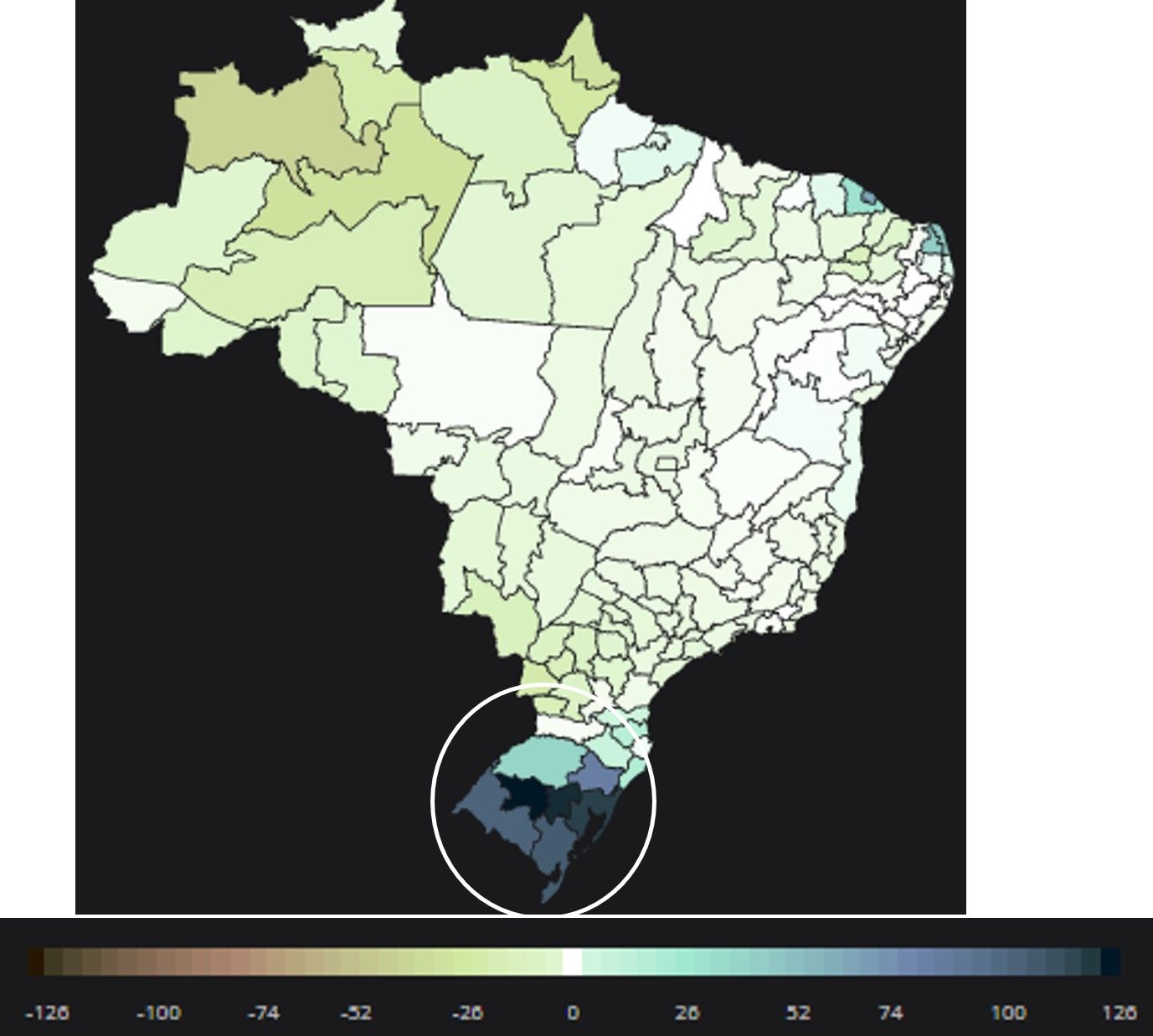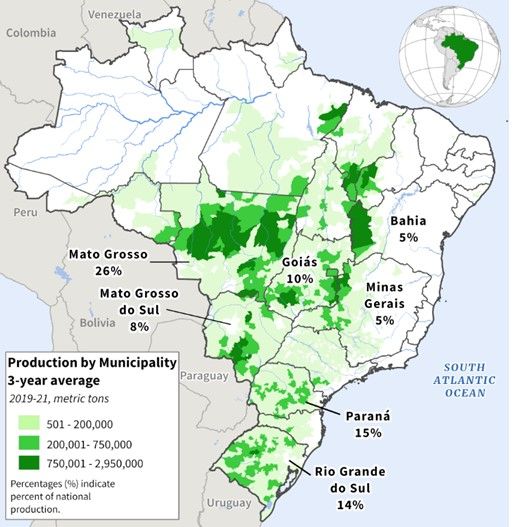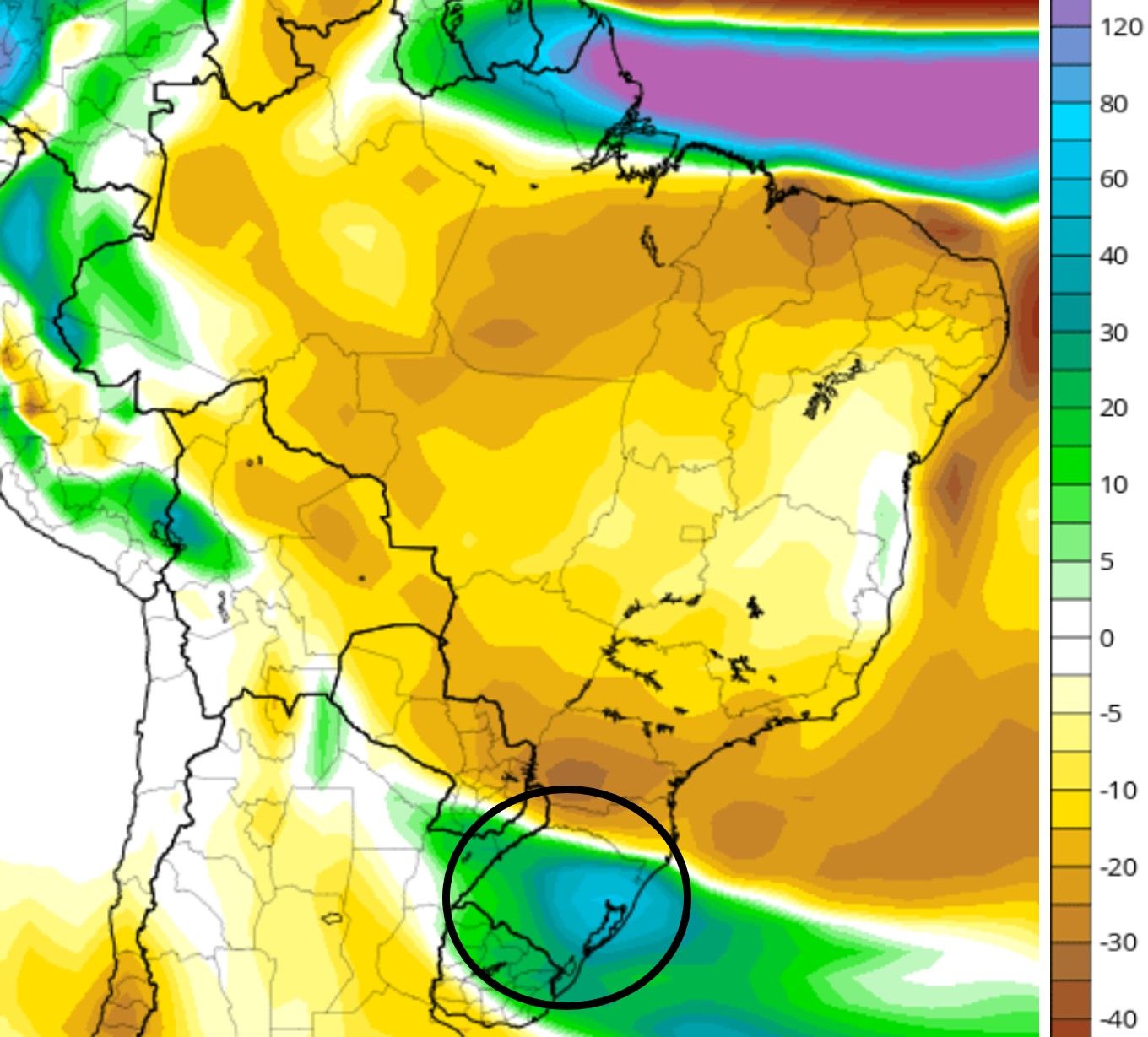
May 3
/
Alef Dias
Grains, Oilseeds and Livestock Quick Take - 2024 05 03
Back to main blog page
Floods in Rio Grande do Sul bring major uncertainties for Brazilian soybeans
- The state of Rio Grande do Sul (RS) has been facing heavy rains that have led to one of the worst floods in its history, with some regions receiving more than 100mm of rain in recent days.
- In addition to the humanitarian impact, the weather event has brought great volatility to the grain markets, given that the state produces a large amount of soybeans, corn and wheat.
- With the rains, the pace of harvesting - which stands at 76% - is lagging behind the same time last season, when it reached 77%. The current harvest rate is also behind the historical average for the period (83%).
- As a result, around 5M mt of soybeans are still "on the ground" in RS and at risk of impact from the floods. It is still very difficult to pinpoint how much of the soybeans that are yet to be harvested will be impacted, with initial estimates pointing to a reduction of 1 to 2M mt of the state's crop.
- The only certainty is that the entire grain production and consumption chain will be impacted by the catastrophe, and that the weather in Rio Grande do Sul will continue to bring volatility to soybean prices in the coming days.
Introduction
The state of Rio Grande do Sul (RS) has been facing heavy rains that have led to one of the worst floods in its history, with some regions receiving more than 100mm of rain in recent days.
More than 130 municipalities were affected, resulting in 24 deaths, with a dam burst in the Serra Gaúcha region. In addition, there have been numerous landslides, damage to infrastructure, rivers overflowing and roads blocked. The state governor described the current scenario as the greatest tragedy ever faced by Rio Grande do Sul.
Fig. 1: Accumulated Precipitation - Last 7 days - Deviation from Normal (mm)

Source: Reuters
In addition to the humanitarian impact, the weather event has brought great volatility to the grain markets, given that the state produces a large amount of soybeans, corn and wheat.
Fig. 2: Soybean Production in Brazil by State and Municipality (mt)

Source: USDA
What are the impacts on crops?
First of all, it's worth remembering that the soybean harvest in the state is already well underway. By Thursday, the harvest had reached 76% of the area planted in the state, an advance of 10 percentage points on the previous week, but it was interrupted after storms hit the crops this week, Emater said in a report.
With the rains, the pace of harvesting is lagging behind the same time last season, when it reached 77%. The current harvest rate is also behind the historical average for the period (83%).
As a result, around 5M mt of soybeans are still "in the ground" in RS and at risk of impact from the floods. In the case of corn, in addition to the state producing a smaller volume (around 5M mt are expected for the 23/24 harvest), the percentage harvested is also higher - 83% - leaving less than 1M mt at risk of impact from the floods.
Fig. 3: Soybean Crop Progress - Rio Grande do Sul

Source: Emater/RS
As a result, the market is turning its attention to soybeans. It is still very difficult to determine how much of the soybeans that are yet to be harvested will be affected. The fields are still flooded in the most affected regions, and the forecast for the next few days shows continued rain, making it difficult for these areas to dry out and for harvest work to resume.
Fig. 4: Expected Accumulated Precipitation over the next 7 days - Deviation from Normal (mm)

Source: Tropical Tidbits
However, local agents are already working on a reduction of 1 to 2M mt in the state's crop, not to mention that the excessive humidity is likely to cause quality issues. Logistics issues have also had an impact on the entire production and consumption chain, with significant consequences for the poultry and pork sector. With roads and bridges blocked, farms are unable to receive feed and send animals to slaughter plants in the state, the third largest in terms of chicken and pork production.
In summary
It is still difficult to pinpoint the total impact of the floods and heavy rains in Rio Grande do Sul on the soybean crop. The first estimates point to an impact of 1 to 2M mt, but many areas are still flooded and the forecasts are for continued rain over the next few days throughout the state.
The only certainty is that the entire grain production and consumption chain will be impacted by the catastrophe, and that the weather in Rio Grande do Sul will continue to bring volatility to soybean prices in the coming days.
Weekly Report — Grains and Oilseeds
Written by Alef Dias
alef.dias@hedgepointglobal.com
Reviewed by Thais Italiani
thais.italiani@hedgepointglobal.com
thais.italiani@hedgepointglobal.com
www.hedgepointglobal.com
Disclaimer
This document has been prepared by hEDGEpoint Global Markets LLC and its affiliates ("HPGM") exclusively for informational and instructional purposes, without the purpose of creating obligations or commitments with third parties, and is not intended to promote an offer, or solicitation of an offer, to sell or buy any securities or investment products. HPGM and its associates expressly disclaim any use of the information contained herein that may result in direct or indirect damage of any kind. If you have any questions that are not resolved in the first instance of contact with the client (client.services@hedgepointglobal.com), please contact our internal ombudsman channel (ouvidoria@hedgepointglobal.com) or 0800-878-8408 (for clients in Brazil only).
Contact us
hedgepointhub.support@hedgepointglobal.com
ouvidoria@hedgepointglobal.com
Funchal Street, 418, 18º floor - Vila Olímpia São Paulo, SP, Brasil
Check our general terms and important notices.
This page has been prepared by Hedgepoint Schweiz AG and its affiliates (“Hedgepoint”) solely for informational and instructional purposes, without the purpose of instituting obligations or commitments to third parties, nor is it intended to promote an offer, or solicitation of an offer of sale or purchase relating to any securities, commodities interests or investment products. Hedgepoint and its associates expressly disclaim any use of the information contained herein that directly or indirectly result in damages or damages of any kind. Information is obtained from sources which we believe to be reliable, but we do not warrant or guarantee the timeliness or accuracy of this information. The trading of commodities interests such as futures, options, and swaps involves substantial risk of loss and may not be suitable for all investors. You should carefully consider wither such trading is suitable for you in light of your financial condition. Past performance is not necessarily indicative of future results. Customers should rely on their own independent judgement and/or advisors before entering in any transaction.Hedgepoint does not provide legal, tax or accounting advice and you are responsible for seeking any such advice separately.Hedgepoint Schweiz AG is organized, incorporated, and existing under the laws of Switzerland, is filiated to ARIF, the Association Romande des Intermédiaires Financiers, which is a FINMA-authorized Self-Regulatory Organization. Hedgepoint Commodities LLC is organized, incorporated, and existing under the laws of the USA, and is authorized and regulated by the Commodity Futures Trading Commission (CFTC) and a member of the National Futures Association (NFA) to act as an Introducing Broker and Commodity Trading Advisor. HedgePoint Global Markets Limited is Regulated by the Dubai Financial Services Authority. The content is directed at Professional Clients and not Retail Clients. Hedgepoint Global Markets PTE. Ltd is organized, incorporated, and existing under the laws of Singapore, exempted from obtaining a financial services license as per the Second Schedule of the Securities and Futures (Licensing and Conduct of Business) Act, by the Monetary Authority of Singapore (MAS). Hedgepoint Global Markets DTVM Ltda. is authorized and regulated in Brazil by the Central Bank of Brazil (BCB) and the Brazilian Securities Commission (CVM). Hedgepoint Serviços Ltda. is organized, incorporated, and existing under the laws of Brazil. Hedgepoint Global Markets S.A. is organized, incorporated, and existing under the laws of Uruguay. In case of questions not resolved by the first instance of customer contact (client.services@Hedgepointglobal.com), please contact internal ombudsman channel (ombudsman@hedgepointglobal.com – global or ouvidoria@hedgepointglobal.com – Brazil only) or call 0800-8788408 (Brazil only).Integrity, ethics, and transparency are values that guide our culture. To further strengthen our practices, Hedgepoint has a whistleblower channel for employees and third-parties by e-mail ethicline@hedgepointglobal.com or forms Ethic Line – Hedgepoint Global Markets.Security note: All contacts with customers and partners are conducted exclusively through our domain @hedgepointglobal.com. Do not accept any information, bills, statements or requests from different domains and pay special attention to any variations in letters or spelling, as they may indicate a fraudulent situation.“HedgePoint” and the “HedgePoint” logo are marks for the exclusive use of HedgePoint and/or its affiliates. Use or reproduction is prohibited, unless expressly authorized by HedgePoint. Furthermore, the use of any other marks in this document has been authorized for identification purposes only. It does not, therefore, imply any rights of HedgePoint in these marks or imply endorsement, association or seal by the owners of these marks with HedgePoint or its affiliates.
We have updated our Terms & Conditions to reflect improvements to our platform, data handling practices, and the overall experience we provide to our clients.
To continue using the Hedgepoint HUB, please review and accept the updated terms.

